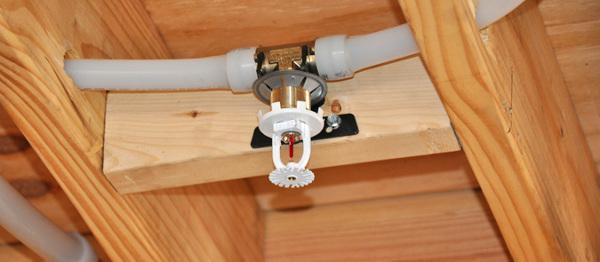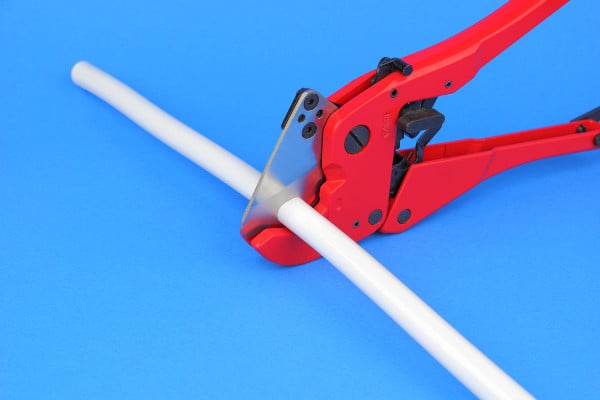Flexible PEX tube has become extremely popular in residential wet fire sprinklers – but what about dry and preaction set-ups?
We were recently asked whether PEX tube can be used in a dry fire sprinkler system. A life safety maintenance professional cited an example of a dry system with PEX that was questioned by the local fire marshal. It’s a good question:
Can you use PEX in a dry – or, for that matter, preaction – fire sprinkler system?
The short answer is “no.” The complicated answer is “theoretically.” And the final, practical answer, at least as of 2018, remains “no.”
Read on for the full explanation.
What can be used where is a function of local fire code, NFPA code, and safety testing and listings
The ultimate approval for any life safety set-up, including sprinkler systems, lies with your local authority having jurisdiction (AHJ). AHJ’s follow local government code, which is often an adoption of state code, potentially with modifications or additions. State code is typically derived from the International Fire Code (IFC) and its corresponding International Building Code (IBC). The majority of US cities and states rely on the IBC, though local regulations sometimes lag behind its latest edition.
And while IBC code can differ somewhat from the guidance issued by the National Fire Protection Association (NFPA) – for example, there are additional requirements for the placement of standpipe hose outlets in certain buildings – the IBC is informed by NFPA code. In the case of fire sprinkler systems, this means:
NFPA 13: Standard for the Installation of Sprinkler Systems
NFPA 13R: Standard for the Installation of Sprinkler Systems in Low-Rise Residential Occupancies
This typical chain of responsibility shows why the answer to any question is usually best found by asking the AHJ (often, your local fire marshal), checking with local code, and ultimately looking at NFPA documents. Unfortunately, these avenues don’t always have a clear answer.
NFPA is “silent on the issue” of PEX in dry or preaction fire sprinklers – but silence does not mean approval
After cracking the NFPA code books and coming up empty on specific guidance about PEX in dry or preaction systems, we went straight to NFPA to ask for a definitive ruling.
“We don’t reference it at all,” explained David Hague, a principal fire protection engineer at NFPA with over 23 years of experience in fire safety. “NFPA 13D is silent on the issue. We don’t say one way or another whether you can use PEX [in a dry or preaction system].”
“This is a UL listing limitation,” continued Hague. “Per the UL listing for [PEX], it’s only been investigated for use in wet systems, not dry or preaction [systems]. We just don’t how it’s going to behave in that environment.”
NFPA develops its standards based on experience, detailed input from life safety professionals, the operational history of deployed systems, and extensive testing done by safety organizations. UL, formerly called Underwriters Laboratories, is a “global safety consulting and certification company” that conducts testing on fire safety materials and components.
When NFPA stipulates that a certain item or material must be “listed,” it means that it has been tested and approved for use in that specific application. The relevant listing document that applies to PEX (and other thermoplastics) is UL 1821: Standard for Thermoplastic Sprinkler Pipe and Fittings for Fire Protection Service. As mentioned by Hague, this standard only covers the use of PEX thermoplastic pipe for wet systems in light hazard commercial and residential occupancies.
“That leaves it up to whether someone would want to go through the testing [of PEX for use in dry and preaction systems] or not,” said Hague.
In this case, that “someone” would likely be a manufacturer of PEX such as Uponor.
An interesting wrinkle to this question is that PEX might work fine in a dry or preaction system. It simply hasn’t been tested, however, so no one can be certain. And it’s best not to take chances with life safety, or run the risk of running afoul of code enforcement by your local AHJ.
So, what fire sprinkler systems can definitively use PEX?
PEX, which is the “most-installed piping product for potable plumbing systems in residential applications nationwide,” was first explicitly approved for wet, multipurpose, residential fire sprinkler systems, as long as the tubes were not in placed in areas that could be exposed to flame. NFPA expanded its potential use after Uponor’s AquaSafe PEX received an exposed safety listing (with certain limitations) in 2015, plus when NFPA added 2013 guidelines that enable PEX to be used in standalone fire sprinkler systems under certain conditions.

Specifically, “PEX or any other listed nonmetallic material can now be used in a standalone wet fire sprinkler system ‘if the maximum static pressure from the water supply does not exceed 80 psi’ – or a pressure release valve and an automatic means of pressure release is used when the pressure from the water supply is higher than this limit.”
Sections 5.2.2.4, 5.2.2.4.1, and 5.2.2.4.2 of NFPA 13D outline these conditions. And of course, it also remains approved for use in multipurpose systems.
For a deeper look at the advantages and disadvantages of PEX vs. CPVC pipe compared to metallic options, as well as how and where PEX can be used, read our blog: “CPVC vs. PEX: What’s the Best Choice for Home Fire Sprinkler Systems?”
PEX is a great option for wet residential applications – but not dry or preaction systems
PEX has gained massive popularity in residential fire sprinkler systems for good reason – it’s durable, easier and cheaper to install than many other options, resistant to corrosion and freeze damage, uses fewer fittings than CPVC or metal, and water passes through PEX tube with much less friction than metallic pipe.
“The majority of multipurpose [residential] systems are PEX,” said Tom Noble, CET, a technical programs specialist at the American Fire Sprinkler Association. “There’s no real advantage to metal pipe; the internal roughness of steel is less forgiving.”
Nevertheless, despite the advantages of PEX and its potential for use in broader applications, it is not safety listed for use in dry or preaction systems. For a pipe to become listed, safety organizations test a material for impact resistance, its coefficient of friction, it’s corrosion potential, and pressure tolerances, among other factors. Since dry and preaction systems have pipe that’s filled with pressurized air or nitrogen instead of water – and thus tend to be more susceptible to certain forms of corrosion than wet systems, for example – unique testing must be done to make sure a material will perform well and continue doing so under these conditions.
Bottom line: Only use material that is listed for use in a dry or preaction system. As of now, PEX is not one of them.
If you have any other questions about your fire sprinkler system, or you need help finding a replacement part or critical component, add a comment below, give us a call at 888.392.3362, or fill out our contact form.


